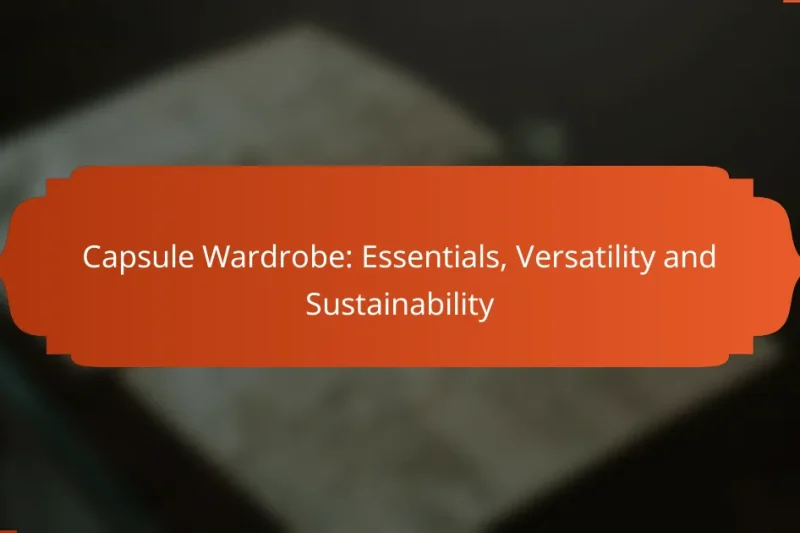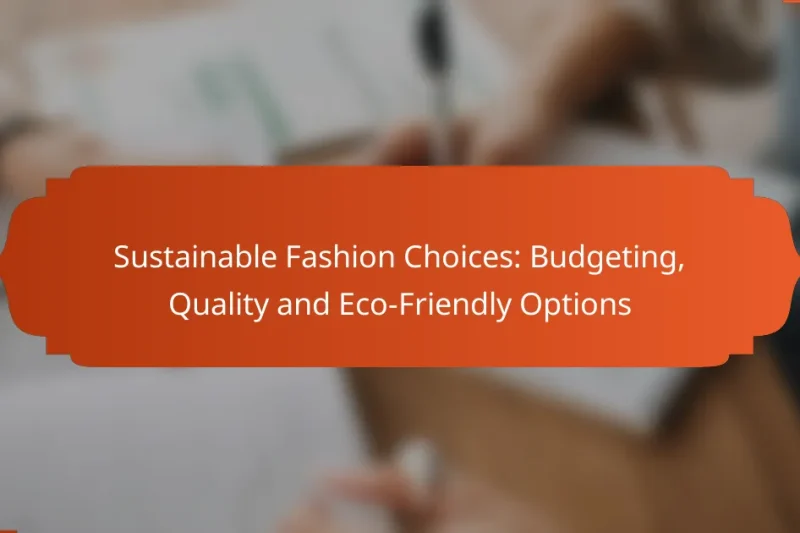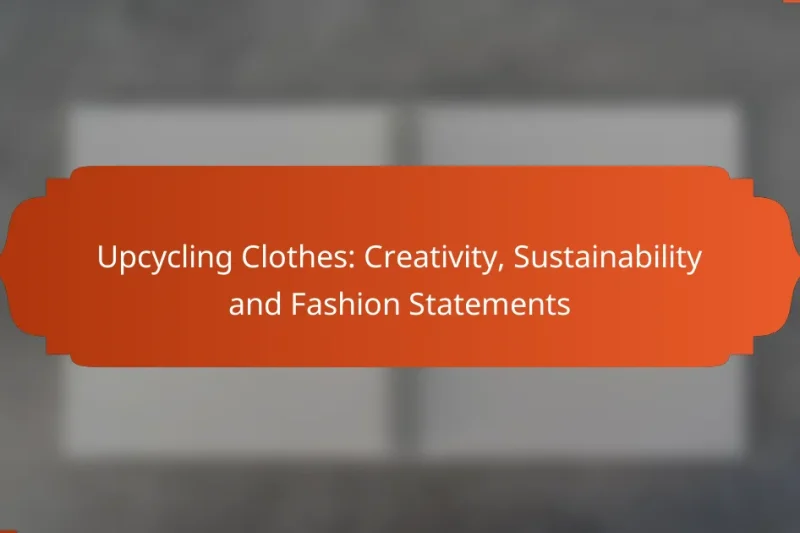Proper clothing care is essential for enhancing the longevity of your garments, as it minimizes wear … Clothing Care: Longevity, Sustainability and Cost-EffectivenessRead more
Best Practices in Sustainable Fashion
Sustainable fashion emphasizes reducing environmental harm and upholding ethical standards in clothing production. By adopting practices such as using organic materials, ensuring fair labor conditions, and promoting recycling, the industry can move towards a more responsible future. Consumers play a crucial role by choosing brands that prioritize sustainability and making mindful purchasing decisions.
Thrift Shopping: Savings, Unique Finds and Eco-Friendliness
Thrift shopping is a savvy way to save money while uncovering unique treasures, from vintage clothing … Thrift Shopping: Savings, Unique Finds and Eco-FriendlinessRead more
Capsule Wardrobe: Essentials, Versatility and Sustainability
A capsule wardrobe is a curated collection of essential clothing pieces designed for versatility and sustainability, … Capsule Wardrobe: Essentials, Versatility and SustainabilityRead more
Fashion Swaps: Community, Sustainability and Cost Savings
Fashion swaps are a creative solution for fostering sustainability within urban communities by allowing individuals to … Fashion Swaps: Community, Sustainability and Cost SavingsRead more
Sustainable Fashion Choices: Budgeting, Quality and Eco-Friendly Options
Sustainable fashion is increasingly accessible for budget-conscious shoppers, offering stylish options that prioritize both affordability and … Sustainable Fashion Choices: Budgeting, Quality and Eco-Friendly OptionsRead more
Upcycling Clothes: Creativity, Sustainability and Fashion Statements
Upcycling clothes is a vibrant movement that combines creativity with sustainability, allowing individuals to transform old … Upcycling Clothes: Creativity, Sustainability and Fashion StatementsRead more
Renting Clothes: Sustainability, Variety and Cost-Effectiveness
Renting clothes is an innovative solution that promotes sustainability by decreasing the demand for new garments, … Renting Clothes: Sustainability, Variety and Cost-EffectivenessRead more
What are the best practices for sustainable fashion?
The best practices for sustainable fashion focus on minimizing environmental impact and promoting ethical standards throughout the production process. Key strategies include using organic materials, ensuring ethical labor practices, recycling and upcycling, maintaining transparency in supply chains, and adopting eco-friendly packaging solutions.
Use of organic materials
Using organic materials is a fundamental practice in sustainable fashion. Organic cotton, hemp, and linen are grown without harmful pesticides and fertilizers, reducing soil and water pollution. Brands should prioritize materials certified by recognized standards, such as GOTS (Global Organic Textile Standard), to ensure authenticity.
When selecting organic materials, consider the lifecycle of the fabric. For example, organic cotton may require more water than synthetic fibers, but it is biodegradable and less harmful to the environment. Aim to source materials from local suppliers to reduce transportation emissions.
Ethical labor practices
Ethical labor practices are crucial for ensuring fair treatment and safe working conditions for garment workers. This includes paying living wages, providing safe working environments, and respecting workers’ rights to organize. Brands should conduct regular audits and partner with organizations that promote fair labor standards.
To support ethical labor, consumers can look for certifications such as Fair Trade or WRAP (Worldwide Responsible Accredited Production). Engaging directly with brands about their labor practices can also encourage transparency and accountability.
Recycling and upcycling techniques
Recycling and upcycling techniques help reduce textile waste and extend the lifecycle of garments. Recycling involves breaking down old fabrics to create new materials, while upcycling creatively transforms discarded items into new products. Brands can implement take-back programs to encourage consumers to return worn items for recycling.
Consumers can participate in upcycling by repurposing old clothing into new fashion items, such as turning jeans into bags or t-shirts into quilts. This not only reduces waste but also fosters creativity and individuality in fashion choices.
Transparency in supply chains
Transparency in supply chains is essential for building consumer trust and ensuring ethical practices. Brands should disclose information about their sourcing, production processes, and labor conditions. This can be achieved through detailed product labeling and online transparency reports.
Consumers can support transparent brands by researching their supply chains and choosing those that openly share their practices. Tools like the Fashion Transparency Index can help identify brands committed to transparency.
Eco-friendly packaging solutions
Eco-friendly packaging solutions minimize waste and environmental impact. Brands can use biodegradable materials, recycled paper, or reusable packaging to reduce their carbon footprint. Avoiding plastic and excessive packaging is crucial in this effort.
Consumers can also play a role by opting for brands that prioritize sustainable packaging. When receiving products, consider reusing packaging materials or recycling them properly to further reduce waste.
How can consumers support sustainable fashion brands?
Consumers can support sustainable fashion brands by making informed choices that prioritize ethical practices and environmental responsibility. This includes selecting brands that adhere to sustainability certifications, engaging in clothing swaps, and focusing on high-quality items that last longer.
Choosing certified brands
Selecting certified brands is a straightforward way to ensure your fashion choices align with sustainability principles. Look for certifications such as Global Organic Textile Standard (GOTS), Fair Trade, or OEKO-TEX, which indicate adherence to environmental and social standards.
When shopping, check the brand’s website or product labels for these certifications. This not only supports ethical practices but also encourages more brands to adopt sustainable methods.
Participating in clothing swaps
Clothing swaps are an effective way to refresh your wardrobe while promoting sustainability. By exchanging items with friends or at community events, you reduce waste and extend the life cycle of clothing.
Consider organizing a swap event in your neighborhood or joining local groups focused on sustainable fashion. This not only helps you find new pieces but also fosters a community around conscious consumption.
Investing in quality over quantity
Investing in quality clothing rather than buying numerous low-cost items is crucial for sustainable fashion. High-quality garments tend to last longer, reducing the frequency of purchases and overall waste.
When shopping, focus on timeless styles and durable materials. Aim for a capsule wardrobe that includes versatile pieces you can mix and match, which minimizes the need for excessive clothing.
What are the environmental impacts of fast fashion?
Fast fashion significantly harms the environment through high carbon emissions, water pollution, and excessive textile waste. These impacts stem from the rapid production cycles and low-cost materials that characterize the industry.
High carbon emissions
The fast fashion industry is a major contributor to global carbon emissions, accounting for a substantial percentage of the total. The production processes, including manufacturing and transportation, often rely on fossil fuels, leading to increased greenhouse gas emissions.
To mitigate these emissions, brands can adopt sustainable practices such as using renewable energy sources and optimizing supply chains. Consumers can also make a difference by choosing brands that prioritize eco-friendly production methods.
Water pollution and waste
Fast fashion contributes to significant water pollution through the use of toxic dyes and chemicals in textile production. These substances often end up in waterways, harming aquatic ecosystems and local communities.
Additionally, the industry consumes vast amounts of water, with estimates suggesting that producing a single cotton shirt can require thousands of liters. To combat this, brands should implement stricter regulations on wastewater management and consumers can opt for sustainable fabrics that require less water.
Excessive textile waste
The fast fashion model promotes a culture of disposability, leading to enormous amounts of textile waste. Millions of tons of clothing end up in landfills each year, where they can take decades to decompose.
To address this issue, companies can focus on creating durable, timeless pieces and encourage recycling programs. Consumers can help by buying second-hand clothing and donating or recycling items they no longer wear, reducing the overall waste generated by the fashion industry.
Which brands are leading in sustainable fashion?
Several brands are at the forefront of sustainable fashion, focusing on eco-friendly practices and ethical production. Notable leaders include Patagonia, Eileen Fisher, and Everlane, each implementing unique strategies to promote sustainability in the fashion industry.
Patagonia’s eco-initiatives
Patagonia is renowned for its commitment to environmental responsibility, integrating eco-initiatives into its business model. The company uses recycled materials in its products and encourages customers to repair and recycle their gear through programs like Worn Wear.
Additionally, Patagonia donates a percentage of its profits to environmental causes, reinforcing its mission to protect the planet. This approach not only enhances brand loyalty but also sets a standard for corporate responsibility in the fashion industry.
Eileen Fisher’s circular design
Eileen Fisher champions circular design by creating clothing that can be reused, recycled, or composted. The brand’s Renew program takes back worn garments, refurbishing them for resale or recycling them into new fibers, minimizing waste.
This commitment to circularity is complemented by a focus on sustainable materials, such as organic cotton and linen. By prioritizing these practices, Eileen Fisher not only reduces its environmental impact but also encourages consumers to think critically about their clothing choices.
Everlane’s transparency model
Everlane is recognized for its transparency model, providing customers with detailed information about the costs associated with each product. This approach includes disclosing the true cost of production, labor, and materials, fostering trust and accountability.
By emphasizing ethical manufacturing practices and fair labor conditions, Everlane appeals to conscious consumers. Their commitment to transparency encourages other brands to adopt similar practices, promoting a more ethical fashion landscape.
What certifications should sustainable fashion brands have?
Sustainable fashion brands should obtain certifications that verify their commitment to environmental and social responsibility. Key certifications include Global Organic Textile Standard (GOTS), Fair Trade Certification, and OEKO-TEX Standard 100, each focusing on different aspects of sustainability.
Global Organic Textile Standard (GOTS)
The Global Organic Textile Standard (GOTS) is a leading textile processing standard for organic fibers. It ensures that textiles are made from at least 70% organic fibers and that the entire supply chain adheres to strict environmental and social criteria.
Brands seeking GOTS certification must comply with regulations regarding water usage, chemical management, and waste disposal. Additionally, they must demonstrate fair labor practices, including safe working conditions and fair wages for workers.
Fair Trade Certification
Fair Trade Certification focuses on equitable trade practices, ensuring that producers in developing countries receive fair compensation for their goods. This certification promotes sustainable livelihoods and community development through fair pricing and ethical trading relationships.
Brands with Fair Trade Certification often support community projects and environmental initiatives. When purchasing Fair Trade products, consumers can look for labels that indicate the certification, ensuring their choices contribute to social equity.
OEKO-TEX Standard 100
OEKO-TEX Standard 100 is a certification that tests textiles for harmful substances, ensuring they are safe for human health. This standard applies to all stages of textile production, from raw materials to finished products.
Brands that achieve OEKO-TEX certification demonstrate a commitment to consumer safety by ensuring their products are free from harmful chemicals. Shoppers can identify OEKO-TEX certified items by looking for the certification label, providing peace of mind regarding the safety of their clothing.
How can technology enhance sustainable fashion?
Technology can significantly enhance sustainable fashion by improving resource efficiency, reducing waste, and enabling better supply chain transparency. Innovations such as 3D printing, digital design tools, and blockchain can help brands create more sustainable products while minimizing their environmental impact.
Innovative materials and production techniques
New materials like organic cotton, recycled polyester, and biodegradable fabrics are transforming the fashion industry. These materials often require less water and energy to produce compared to traditional fabrics. Additionally, production techniques such as digital printing and 3D knitting can reduce waste by creating garments on demand rather than in bulk.
Supply chain transparency
Technology enables brands to track their supply chains more effectively, ensuring ethical sourcing and production practices. Blockchain technology, for instance, can provide verifiable information about the origin of materials and labor conditions. This transparency helps consumers make informed choices and encourages brands to uphold sustainable practices.
Consumer engagement and education
Digital platforms and social media play a crucial role in educating consumers about sustainable fashion. Brands can use these channels to share their sustainability efforts, promote eco-friendly products, and engage with customers on environmental issues. This engagement fosters a community of conscious consumers who prioritize sustainability in their purchasing decisions.






